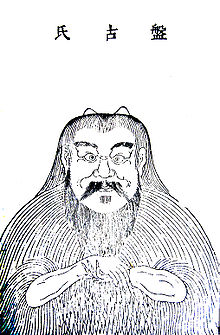Our website is made possible by displaying online advertisements to our visitors.
Please consider supporting us by disabling your ad blocker.
Pangu
| Pangu | |||||||||||||||||||||||
|---|---|---|---|---|---|---|---|---|---|---|---|---|---|---|---|---|---|---|---|---|---|---|---|
 Portrait of Pangu from Sancai Tuhui | |||||||||||||||||||||||
| Traditional Chinese | 盤古 | ||||||||||||||||||||||
| Simplified Chinese | 盘古 | ||||||||||||||||||||||
| Literal meaning | Ancient dome[citation needed] | ||||||||||||||||||||||
| |||||||||||||||||||||||
| Part of a series on |
| Chinese folk religion |
|---|
 |
Pangu or Pan Gu[1] (Chinese: 盤古, PAN-koo) is a primordial being and creation figure in Chinese mythology and in Taoism. According to legend, Pangu separated heaven and earth, and his body later became geographic features such as mountains and roaring water.
- ^
Kwang-Chih Chang (13 March 1999). "China on the Eve of the Historical Period". In Loewe, Michael; Shaughnessy, Edward L. (eds.). The Cambridge History of Ancient China: From the Origins of Civilization to 221 BC. Cambridge histories online. Cambridge: Cambridge University Press. p. 68. ISBN 9780521470308. Retrieved 7 December 2024.
[...] the other cosmogonic myths - the two versions of Pan Gu's creation and the story of the ten suns - could be at least as early as the time of the Three Dynasties, or, as I believe to be more likely, even earlier still, going well back into the Upper Palaeolithic period.
Previous Page Next Page



